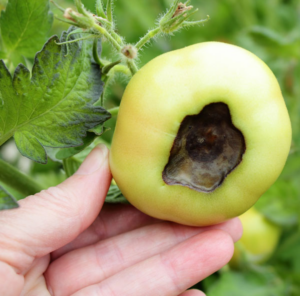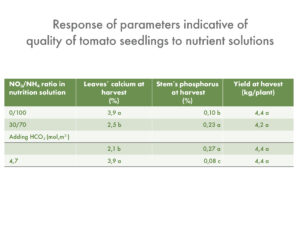Despite the fact that NO3- assimilation consumes more energy than NH4+ assimilation, few plant species perform well when NH4+ is the sole source of nitrogen, and many plants develop symptoms of toxicity when subjected to high concentrations of NH4+. The damage can be observed as leaf chlorosis, reduced net photosynthesis, lower plant yield, lower cation content and changes in metabolite levels such as amino acids or organic acids.
To investigate if grafting can alleviate the negative effects of ammonium nutrition in a sensitive crop such as tomato, three experiments were carried out in 2008-9, in randomized complete blocks in a greenhouse in Germany. Tomato plants of the cv. Moneymaker were either self-grafted or grafted onto the popular rootstock “Maxifort”. For the first two experiments (in 4 repetitions), plants were transferred to 2L glasses filled with aerated nutrient solution. Vegetative growth parameters and nutrient content of leaves were assessed. In the first experiment the response of plants to 5 pH levels was investigated in a nutrient solution with a high NO3- : NH4+ ratio. The second experiment compared the effect of grafting under four different ratios of NO3- : NH4+ in the nutrient solution, at a constant pH of 5,7±0,1 and total N of 23 mM. The effects of exposure to these ratios of the two nitrogen sources in practice, on nutrient content of the plant and yield, was investigated in the third experiment, on plants grown in gullies supplied continuously with nutrient solution, at a plant density of 1,6 plants m-2, in two repetitions of 6 plants per plot (Table 1).
The pH of the nutrient solution did not have an effect on plant growth nor on N, P or K content in leaves. It did affect the content of other nutrients in the leaves 20 day after transplant: Ca, Mg and Cu concentrations increased, and Fe, Mn and Zn concentrations decreased as pH of the nutrient solution increased from 3,5 to 7,5. This is in line with models predicting the effect of pH on nutrient uptake of plants. Grafted plants had higher Ca, Fe, Zn and Cu concentrations compared to self-grafted plants, but there were no significant interactions between grafting and response to pH.
In the second and third experiment, leaf biomass and fruit yield decreased in response to an increase of NH4+ in the nutrient solution, and macro and micro-element concentrations were also affected by NO3- : NH4+ ratio. The grafting combination did not influence these parameters, nor was an interaction found between N-form and grafting.
Uptake of the major cations Ca2+ and Mg2+ was reduced with increasing external NH4+ concentrations (Table 1). This is explained by the mechanism of charge balance in ion uptake, when the uptake of ammonium cations prevents uptake of other cations to maintain electro-neutrality in the plant. The reduction in plant growth and yield in this experiment is explained by these low calcium and magnesium concentration in the leaves. Calcium deficiency during NH4+ nutrition can induce loss of membrane integrity, lowering magnesium concentration and negatively affecting the function of mitochondria and chloroplasts. This explanation is supported by gas exchange measurements during this experiment, which showed a significant decrease in photosynthetic activity for the 70% and 100% NH4+ treatments. The decrease in marketable yield with increasing NH4+ in the nutrient solution resulted mainly from the increase of fruit physiological disorders (BER), reducing the number of marketable fruits per plant. BER incidence in this experiment was increased with increasing ammonium concentration in the nutrient solution, and negatively correlated with calcium content in the tomato fruits and leaves (Table 1). The grafting of the cultivar ‘Moneymaker’ on the rootstock ‘Maxifort’ did not alleviate the negative effects of ammonium nutrition in a sensitive crop such as tomato.

Table 1. Effect of NO3- : NH4+ ratio in nutrient solution on yield, blossom end rot (BER) and nutrient content in the leaves of fertigated tomato. N-form had a significant effect on all parameters, but no statistically significant variation was found between the graft combinations (two way ANOVA with significant linear effect at p≤ 0,05 (*) or 0,01(**). NS=not significant ).



